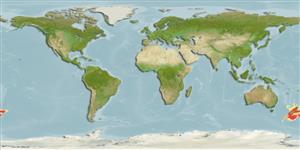Mammalia |
Carnivora |
Otariidae
Environment: milieu / climate zone / depth range / distribution range
Ecology
Bathydemersal. Temperate; 0°N - 90°S, 180°W - 180°E
Southwest Pacific: New Zealand.
Length at first maturity / Size / Weight / Age
Maturity: Lm ? range ? - ? cm Max length : 330 cm TL male/unsexed; (Ref. 1394); 200 cm TL (female); max. published weight: 400.0 kg (Ref. 1394); max. published weight: 400.0 kg
Feeds on squid, flounder, octopus, crustaceans; known to take penguins, fur seal and elephant seal pups on occasion (Ref. 1394). Feeds on squid, flounder, octopus, crustaceans; known to take penguins, fur seal and elephant seal pups on occasion (Ref. 1394).
Life cycle and mating behavior
Maturity | Reproduction | Spawning | Eggs | Fecundity | Larvae
Jefferson, T.A., S. Leatherwood and M.A. Webber. 1993. (Ref. 1394)
IUCN Red List Status (Ref. 130435)
CITES status (Ref. 108899)
Not Evaluated
Not Evaluated
Threat to humans
Human uses
Fisheries: commercial
FAO - Fisheries: species profile | FishSource | Sea Around Us
Tools
More information
Age/Size
Growth
Length-weight
Length-length
Morphology
Larvae
Abundance
Internet sources
Estimates based on models
Preferred temperature
(Ref.
115969): 7.7 - 12, mean 10 (based on 50 cells).
Vulnerability
Very high vulnerability (90 of 100).
Price category
Unknown.
